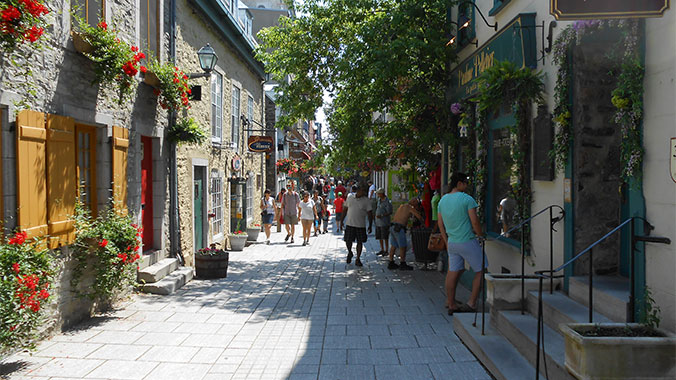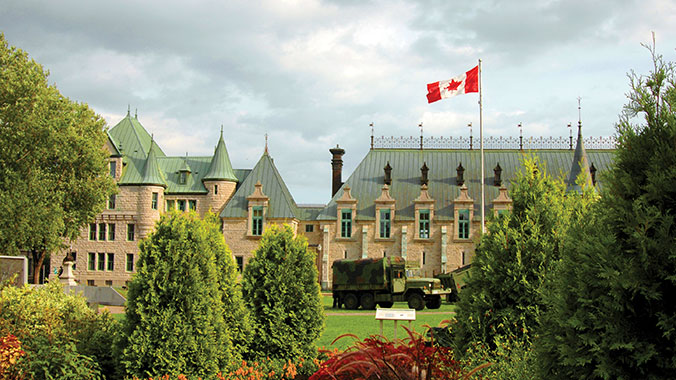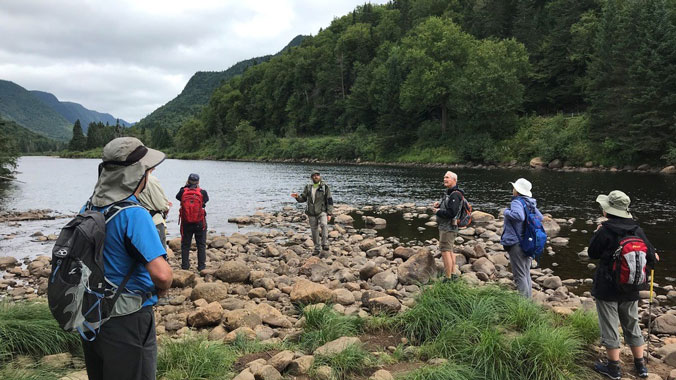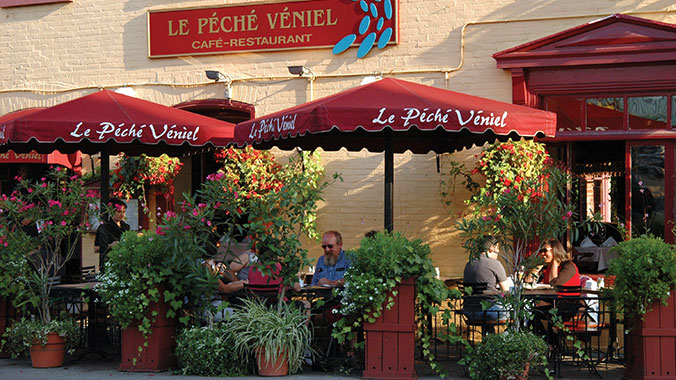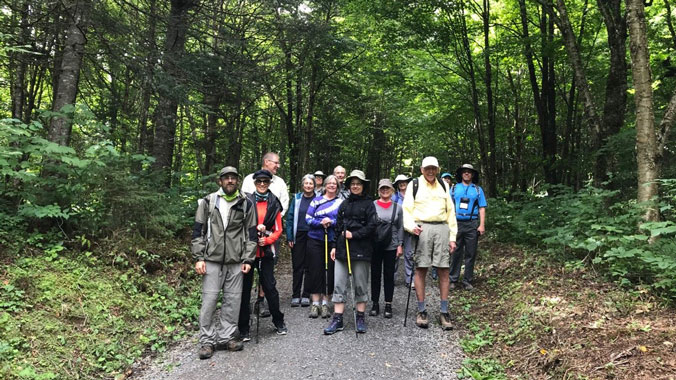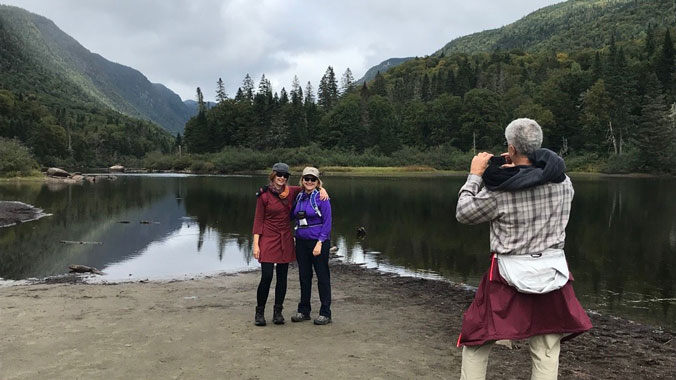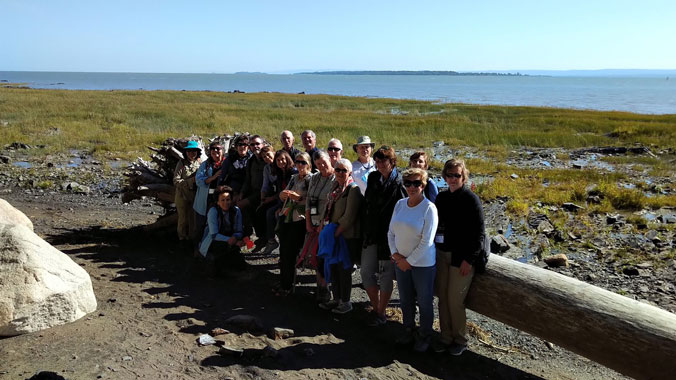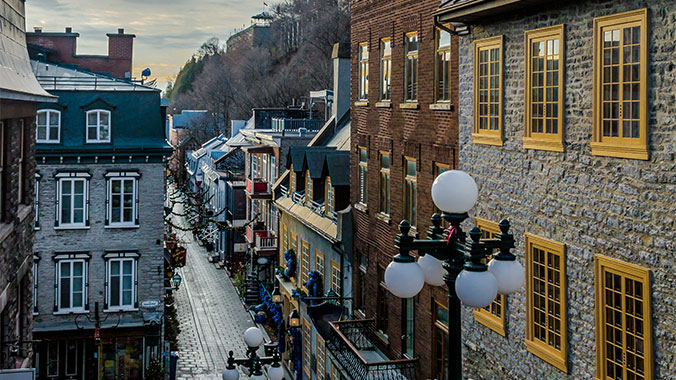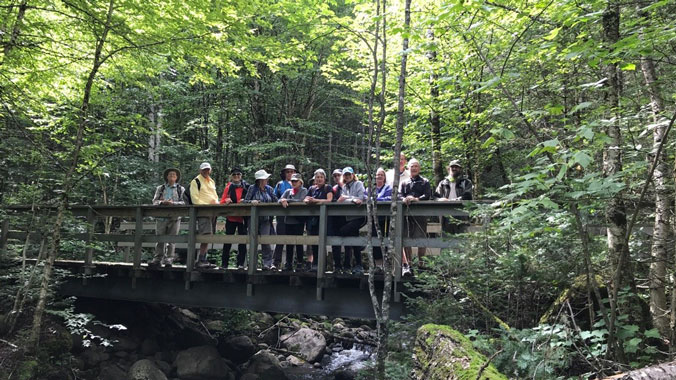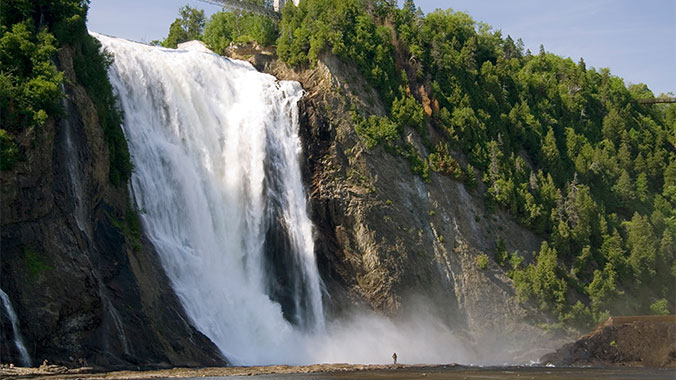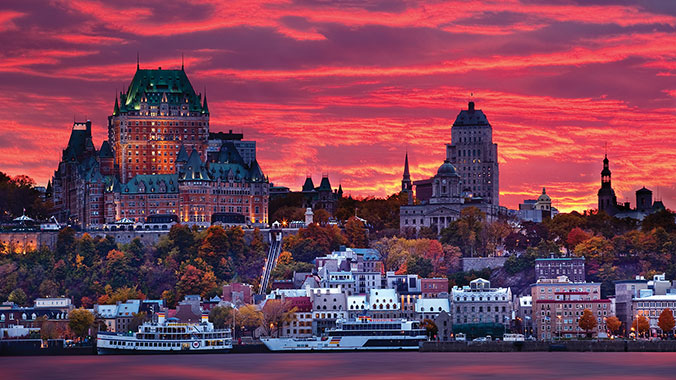Québec
Walking and Hiking in Québec City
Program No. 23165RJ
Take daily hikes across four centuries of history & French Canadian heritage in the urban UNESCO setting of Québec City, the Île d’Orléans & the region’s stunning collection of parks.
Itinerary
While we make every effort to ensure the accuracy of our published materials, programs are typically advertised more than a year prior to their start date.
Read More.
While we make every effort to ensure the accuracy of our published materials, programs are typically advertised more than a year prior to their start date. As a result, some program activities, schedules, accommodations, personnel, and other logistics occasionally change due to local conditions or circumstances. Should a major change occur, we will make every effort to alert you. For less significant changes, we will update you during orientation. Thank you for your understanding.
Duration
5 days
4 nights
What's Included
8 meals (
4B, 2L, 2D
)
1 expert-led lecture
6 expert-led field trips
An experienced Group Leader
4 nights of accommodations
Taxes and customary gratuity
Road Scholar Assurance Plan
Day
1
Check-in, Registration, Orientation, Welcome Dinner
Location:
Quebec City, QC
Meals:
D
Stay:
Le Monastère des Augustines
Activity Note
Hotel check-in available from 4:00 p.m. Remember to bring your nametag (sent previously). Walking up to a mile; Old City terrain.
Afternoon:
Program Registration: 5:15 p.m. After you check in to Le Monastère des Augustines and have your room assignment, join us in the conference room to register with the program staff, get any updated information, and confirm the time and location of the Orientation session. If you arrive late, please locate your Group Leader and let them know you have arrived. Orientation. We will gather in the hotel conference room where the Group Leader will greet everyone and lead introductions. We will review the up-to-date program schedule, discuss roles and responsibilities, logistics, safety guidelines, emergency procedures, and answer questions. This program is staffed with a knowledgeable Group Leader and will also feature local experts. Periods in the schedule designated as “Free time” and “At leisure” offer opportunities to do what you like and make your experience even more meaningful and memorable according to your personal preferences. The Group Leader will be happy to offer suggestions.Program activities, schedules, personnel, and indicated distances or times may change due to local circumstances/conditions. In the event of changes, we will alert you as quickly as possible. Thank you for your understanding.
Dinner:
At the Monastery featuring healthy cuisine.
Evening:
We will set out with our Study Leader who will provide expert commentary as we stroll through the streets of the Old City to the famous Château Frontenac and form our first impressions of Québec as we begin to explore the city. Old Québec is a UNESCO-designated World Heritage Site. From the UNESCO inscription: “Québec was founded by the French explorer Champlain in the early 17th century. It is the only North American city to have preserved its ramparts, together with the numerous bastions, gates and defensive works which still surround Old Québec. The Upper Town, built on the cliff, has remained the religious and administrative centre, with its churches, convents and other monuments like the Dauphine Redoubt, the Citadel and Château Frontenac. Together with the Lower Town and its ancient districts, it forms an urban ensemble which is one of the best examples of a fortified colonial city.” Continue getting to know your fellow Road Scholars, settle in, and get a good night’s rest for the day ahead.
Day
2
Old Québec City, Architecture & History
Location:
Quebec City, QC
Meals:
B,L
Stay:
Le Monastère des Augustines
Activity Note
Walking about 4 miles throughout the day, approximately 3.5 hours total; steep hills, challenging staircases, narrow streets, cobblestones, dirt trail, ascents/descents approximately 300 feet.
Breakfast:
At the Monastery.
Morning:
We will be joined by a local expert who will give us a presentation highlighting the city's foundation and exceptional geographical location as well as present-day social and economic facets. We’ll gain an understanding of how Québec City's history contributed to the creation and development of Canada and why it was designated a World Heritage Site by UNESCO. We will then set out from the monastery lobby on our first walking field trip that will take us to the Plains of Abraham and back to the Old town. Long before the historical battle of 1759, the area situated just outside the city wall was renowned for the diversity of its natural resources. Heading towards the east, we will climb on the fortifications for an overview of military and civil architecture. In the walled city, we will learn about the various districts marked by the presence of French, English, Scottish, and Irish who left a significant legacy of architecture, economic, and political heritage. As we reach Cap Diamond, we will have an amazing view of Québec’s natural harbor made of three ancient geological formations.
Lunch:
At the Château Frontenac, one of the landmarks of Québec City and the most photographed hotel in the world. It was named in honor of Louis de Buade, Comte de Frontenac, who served as the governor of France’s colony in Canada during the late 17th century.
Afternoon:
With our Group Leader, we will explore the lower part of Old Québec near the river — including Quartier Petit-Champlain — that represents centuries of compromises and struggle between people and geography, to facilitate defense and economic development while protecting the natural bounty of the St. Lawrence. The Quartier Petit-Champlain is the site of Québec’s first port. As one of the city’s original neighborhoods, it has gone through various periods of development, decline, and revitalization. Today, after an extensive restoration project, the district exudes an Old World atmosphere with historical architecture and buildings dating back to the 1600s, narrow streets, artisans and craftsmen, charming boutiques, and much more. Before dinner, we will gather in a local bistro for camaraderie and drinks (on your own).
Dinner:
On your own to enjoy what you like. Our Study Leader will be happy to offer suggestions.
Evening:
At leisure. Take this opportunity for independent discovery to see and do what interests you most. Our Group Leader will have suggestions for where you can go and what you can do at the time of the program.
Day
3
Parc national de la Jacques-Cartier
Location:
Quebec City, QC
Meals:
B,L
Stay:
Le Monastère des Augustines
Activity Note
Getting on/off a bus; driving about 30 miles each way, approximately 1 hour. Hiking about 5 miles, approximately 4.5 hours; former forest road, uphills/downhills, mostly shady. Elective 1 mile extension hike; narrow trail, stone steps, roots, dirt, rocks.
Breakfast:
At the Monastery.
Morning:
We will board a bus and ride out to the Laurentian massif for a hiking field trip with our Study Leader in one of the most ancient mountain ranges in the world, home of the Parc National de la Jacques Cartier. The main feature of the park is the famous Rivière Jacques Cartier (Jacques Cartier River) put under the protection of the Park Act in 1981. The river has carved its passage down to more than 1,800 feet below the top of the plateau in a valley that existed even before the glacial period. During the hike, we will learn about the ancient trail connecting Quebec to the Saguenay through the floating timbers period that ended in 1978. The Jacques Cartier National Park is an environmental testament to the role of nature and geography in the development of Canada. Focusing on area history before the European arrival up to modern time, we will gain insights into local conservation efforts of this historical salmon river and protected glacial valley.
Lunch:
In the National Park, we’ll have boxed lunches.
Afternoon:
We’ll return to the hotel mid-afternoon. The remainder of the afternoon is free.
Dinner:
This meal has been excluded from the program cost and is on your own to have what you like. The Group Leader will be happy to offer suggestions.
Evening:
At leisure. You might like to stroll through the Old Town or enjoy coffee and a digestif in a café or bar.
Day
4
Île d'Orléans, Montmorency Falls
Location:
Quebec City, QC
Meals:
B,D
Stay:
Le Monastère des Augustines
Activity Note
Getting on/off a bus; driving about 30 miles each way, approximately 1 hour total riding time. Walking about 3 miles, approximately 3 hours; woody area, dirt and mud, overstepping stones, walking on unstable sand.
Breakfast:
At the Monastery.
Morning:
Our next field trip is to the Île d’Orléans (Orleans Island), which has been called “a shining jewel in Quebec’s crown.” It is the largest district under the protection of the Cultural Property Act and the first agricultural settlement of Nouvelle France. We will board a bus, cross the bridge, and ride to the eastern tip of the island. There, we will immerse ourselves in a wide open view over the estuary where fresh and salt water mix. During a leisurely walk along the riverside, we will reach the intertidal area for a closer connection with the mighty Fleuve St-Laurent (Saint Lawrence River). As we explore, we’ll learn about its wildlife and navigation. We will then ride to St-Jean, considered the most beautiful village of the Island, renowned for its typical neoclassic architecture. As we walk through the village, we will be able to appreciate typical Quebec architecture.
Lunch:
On your own to enjoy what you like in a local bistro.
Afternoon:
Next, we stroll along Montmorency Falls Park to the 272-foot-high Montmorency Fall, a spectacular force of nature rich with military, economic, and cultural history. With commentary by our Group Leader, we will walk on the bridge and enjoy spectacular views of the waterfall, the river, and surroundings.
Dinner:
At a renowned restaurant in Old Québec noted for its local “farm to table” gastronomy. Share favorite experiences and enjoy camaraderie with new Road Scholar friends during our farewell dinner.
Evening:
At leisure. Enjoy a last evening together, step out to see another spot in the city, sip an after dinner drink at a favorite café, or just relax. Prepare for check-out and departure in the morning.
Day
5
Program Concludes, In Transit From Program
Location:
Quebec City, QC
Meals:
B
Activity Note
Monastery check-out by 12:00 Noon.
Breakfast:
At the Monastery. This concludes our program.
Morning:
If you are returning home, safe travels. If you are staying on independently, have a wonderful time. If you are transferring to another Road Scholar program, detailed instructions are included in your Information Packet for that program. We hope you enjoy Road Scholar learning adventures and look forward to having you on rewarding programs in the future. Don’t forget to join our Facebook page and follow us on Instagram. Best wishes for all your journeys!
Please select a day to update the map
Map details are not available for this location.

